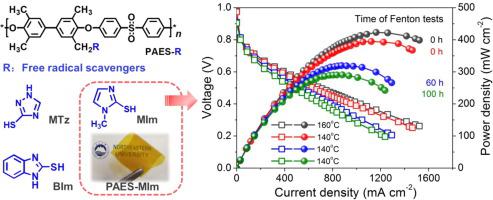Chemical Engineering Journal ( IF 13.3 ) Pub Date : 2020-10-29 , DOI: 10.1016/j.cej.2020.127541 Jin Wang , Yu Dai , Ruiying Wan , Wei Wei , Shicheng Xu , Fuheng Zhai , Ronghuan He

|
The chemical durability is a critical issue to proton exchange membranes (PEMs) for using as the electrolyte in proton exchange membrane fuel cells (PEMFCs). Herein, chemically stable membranes were prepared by grafting organic free radical scavengers (R) including 2-mercapto-1-methylimidazole (MIm), 3-mercapto-1,2,4- triazole (MTz) and 2-mercaptobenzimidazole (BIm) onto backbones of polyarylethersulfone (PAES), respectively. Having a phosphoric acid (PA) doping level of around 200 wt%, the PAES-MIm and PAES-MTz membranes exhibit, separately, anhydrous proton conductivities of 78.3 and 63.3 mS cm-1 at 180 °C, tensile stress at break of 7.8 and 9.4 MPa at room temperature, and a peak power density of 423 mW cm-2 and 358 mW cm-2 at 160 oC with a fuel cell fueling with non-humidified gases of H2 and O2. The properties of the prepared PAES-MIm and PAES-MTz membranes with and without performing the Fenton tests were all investigated on tensile stress, methanol permeability, anhydrous proton conductivity, and polarization curves of single fuel cells, respectively. The results indicate that the grafted free radical scavengers significantly enhanced the chemical stability and retarded the degradation of the PAES-R membranes. After suffered the Fenton test under harsh conditions (H2O2, 3 wt%, Fe2+, 4 ppm at 68 oC) for 60 and 100 h, a peak power density of 320 and 291 mW cm-2 is still achieved at 140 °C by the acid doped PAES-MIm membranes, respectively. Characterizations on the morphology by scanning electron microscope (SEM), and structure by Raman spectroscopy of the prepared membranes were made as well.
中文翻译:

将自由基清除剂接枝到聚芳醚砜骨架上,以提高高温聚合物膜电解质的化学稳定性
对于在质子交换膜燃料电池(PEMFC)中用作电解质的质子交换膜(PEM)而言,化学耐久性是关键问题。本文中,通过将包括2-巯基-1-甲基咪唑(MIm),3-巯基1,2,4-三唑(MTz)和2-巯基苯并咪唑(BIm)的有机自由基清除剂(R)接枝来制备化学稳定的膜聚芳基醚砜(PAES)的骨架。PAES-MIm和PAES-MTz膜具有约200 wt%的磷酸(PA)掺杂水平,分别在180°C下的无水质子电导率分别为78.3和63.3 mS cm -1,断裂拉伸应力为7.8室温下为9.4 MPa,峰值功率密度为423 mW cm -2和358 mW cm -2在160 o C时,燃料电池以H 2和O 2的未加湿气体作为燃料。分别在单燃料电池的拉伸应力,甲醇渗透性,无水质子电导率和极化曲线上研究了制得的PAES-MIm和PAES-MTz膜在进行和不进行Fenton测试时的性能。结果表明,接枝的自由基清除剂显着增强了化学稳定性并阻止了PAES- R膜的降解。经过苛刻的Fenton测试(H 2 O 2,3 wt%,Fe 2 +,4 ppm在68 oC)60和100 h,在140°C下仍分别通过掺酸的PAES-MIm膜达到320和291 mW cm -2的峰值功率密度。还通过扫描电子显微镜(SEM)表征了形态,并通过拉曼光谱对所制备的膜进行了结构表征。









































 京公网安备 11010802027423号
京公网安备 11010802027423号